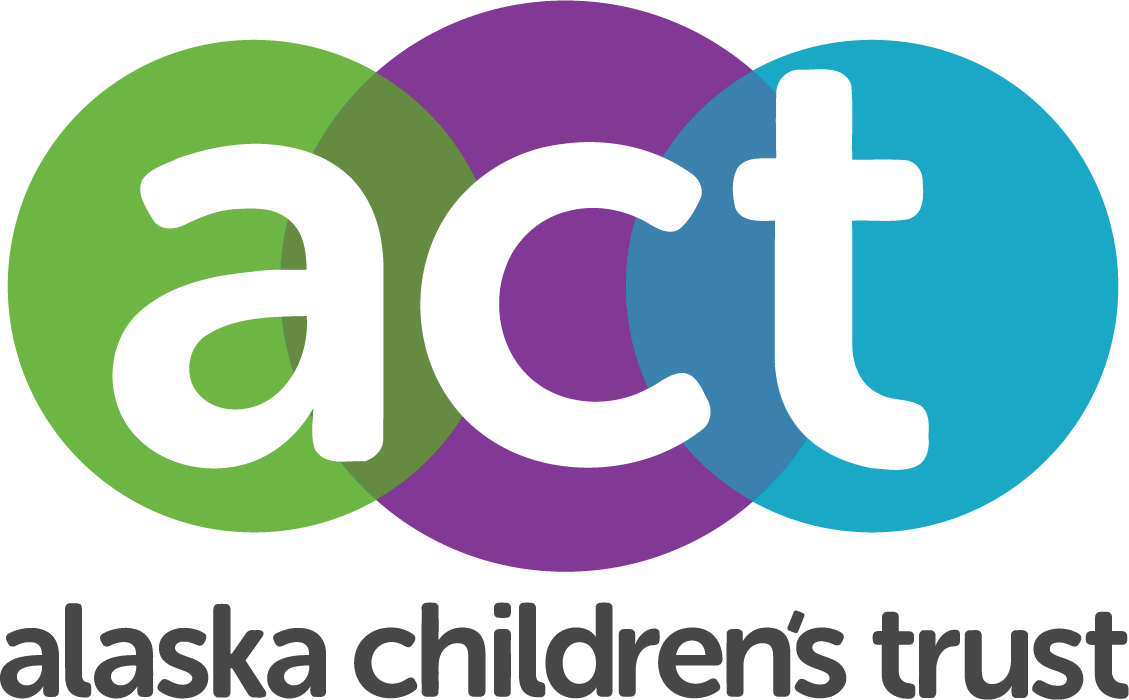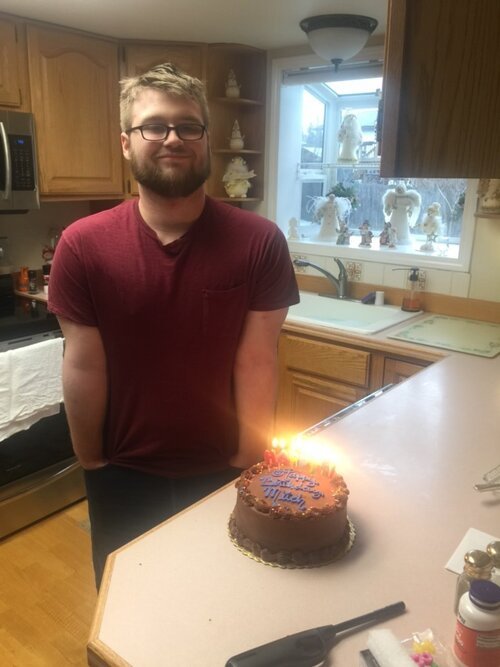Mother's Day in the Midst of a Pandemic
Anna and Mike with their son, Nolan
Families are likely going to be celebrating Mother’s Day a little differently this year, as the COVID-19 pandemic continues to affect nearly every aspect of our lives. In recognition of Mother's Day, we spoke with several different moms, who provided their diverse perspectives on handling the changes in work and family life brought on by COVID-19 – and shared their advice and encouragement for other families.
Anna: “You don’t need to be super mom”
Like everyone, life has changed a lot since the pandemic for Anna McGovern, her husband, Mike, and their 19-month-old son, Nolan.
Anna, a program specialist with the Alaska Afterschool Network, has been working at home since late March. As their day care has been closed due to COVID-19, Nolan is his mom’s new co-worker. “It’s impossible working with a toddler,” she laughs. “He gets into everything and loves to touch my computer.”
As a juvenile probation officer, Anna’s husband, Mike, has continued going into work for the most part, with some remote work from home. This means Anna works around Nolan’s naptime, as well as in the evenings when her husband is home.
“It’s hard to spend all day with the baby, then work until 9 or 10 at night. I’m fortunate that my work is flexible, but it is tiring,” Anna says.
With no day care, library or play dates, Anna and Nolan fill their days with car rides, going outside, FaceTime with friends and family – and lots of walks. “The dog is getting pretty tired of walks. She’s thinking, ‘You’ve never walked me so much!’” Anna says.
Keeping a schedule is one way the family strives to maintain normalcy. Two things Anna makes sure are on the daily schedule: eating dinner together and working out.
“We try to make a point to sit down for dinner all together. We make it a priority and meals together is one thing we’ve really stuck to,” Anna says. “I also try to work out every day, even when I don’t want to. The easiest way to lower stress is to break a sweat for 20 minutes.”
Writing a list of daily goals and jotting down things she is grateful for are other self-care techniques that are helping Anna navigate these strange days.
“There is something about crossing things off a list, even if it’s ‘drink 100 ounces of water a day.’ It’s something I can control in a time when I can’t control anything. That’s really helped,” Anna explains. “Also writing down what I’m grateful for, any little thing that is good. When I get in a mood, I can go back and read it and remind myself that there are still a lot of positive things even though a lot of craziness is going on.”
One thing Anna is grateful for is the extra time she is getting to spend with her son. “At this age especially, they change so fast and learn so quick. It’s fun to experience. Also, I don’t have to choose between being a stay-at-home mom or working. I’m doing both; there is no pressure to be one or the other.”
Anna’s advice for other mothers juggling work, family and the anxiety of these uncertain times? “You don’t need to be super mom,” she says. “It’s a weird time right now. It’s OK to just be an OK parent.”
Diane: “Everyone else is in the same boat”
Diane, Colleen and their two young children, Imogen and Alistair
Before COVID-19 made its entrance in Alaska, Diane Heaney-Mead spent her days working at her architecture office in downtown Anchorage, while her wife, Colleen, ran a home day care for children including their own: Imogen, 1, and Alistair, 3.
Fast-forward several weeks and Diane has been shuffling her work between her daughter’s bedroom to the dining table and back between naps. Meanwhile, Colleen chose to discontinue her business due to social distancing requirements and to protect their son, who is easily affected by respiratory illnesses.
“I often end up working late both because spring is a busy time of year and because I find myself trying to help out with kids during the day,” Diane says. “And our kids have a hard time understanding why we can’t hang out with friends, go out to restaurants or places like the museum.”
Even with all the changes, the family has been adjusting fairly well, which Diane credits to keeping a schedule and setting work/family-time boundaries. “We are trying to keep a pretty similar routine, no hanging out in PJs or watching TV. The kids go for a walk in the morning about the same time each day, and my wife is still providing circle time for our kids,” she says.
“I give everyone a hug and a kiss before I ‘go to work’ in the bedroom and try to be clear about when it is work time and when it is not. I also try to be flexible based on their needs each day,” she adds.
While things are going pretty smoothly, there have been some tough days. “The first week we stayed home, there was a string of gun violence,” Diane explains, recalling a car chase with someone shooting an assault-style weapon out the window, and a separate incident with someone walking down the street shooting a handgun. “It was completely bizarre and not typical for our street.”
The silver lining was that it brought the neighbors together. A Facebook group was established so neighbors could connect and share information. Several people created neighborhood walks with themes like Halloween and space. And Diane and Colleen lent sleds to a nearby mom so she could tire out her active kids. “I don’t know that we would have connected as well unless we had all been home like this,” Diane says.
Spending more time as a family is another upside. “I get to spend more time with the children,” Diane says. “And last weekend we had the opportunity to look after a friend’s son for the weekend while she was giving birth. It was our children’s first time having a friend sleep over and made for a nice break from the isolation.”
When it comes to encouragement for other families, Diane says, “Hang in there. When kids run up during a web conference, I just remind myself that everyone else is in the same boat.”
Andrea: “We don’t always have to be doing something”
Andrea's adopted son, Mitch
Life hasn’t really changed that much since the pandemic for Andrea Conter, her 21-year-old adopted son, and her two high-school-age foster boys. Unless you count the fact that Andrea isn’t working, her oldest son is now just working part-time, and the younger boys are schooling from home.
This is a family used to living with change, which is perhaps the reason they are taking the current situation in stride. Growing up in foster homes, the three boys are certainly familiar with frequent change – in homes, caregivers, schools, schedules. And Andrea, who became a mother just three years ago at the age of 52, has adapted to quite a bit of change in her life recently as well.
As a single, career-focused woman, Andrea never thought she could foster children because her lifestyle didn’t allow her to care for young children. However, three summers ago, when she saw a Facebook post seeking a foster family for a college-age boy, she realized that older children needed homes as well. Soon after, she welcomed Mitch into her home. And last spring, at an adoption ceremony in Anchorage, Andrea and Mitch officially became mother and son.
More change came a couple months later when Andrea got a call asking if she would foster two brothers on a temporary basis. Almost a year later, the two boys are still part of the family.
“Prior to COVID, we just did normal stuff – school, work, homework, gaming, friends,” says Andrea, who is a store manager at Burlington.
When COVID hit Alaska, that all changed. Instead of working full-time managing 80 employees, Andrea now completes several hours of virtual training each week and tries to keep her employees engaged over social media. Mitch’s work schedule was reduced to part-time, and he and Andrea share the grocery shopping responsibility. And the younger boys have transitioned to doing school from home.
“The biggest change is now we are all home all day. Things have been OK except for battling to get them to do homework,” Andrea notes.
All the ZOOM meetings and school emails are somewhat overwhelming, but Andrea says she likes to see the assignments and due dates and grades. She’s also been thrilled to see the change in her oldest foster son, who left a more stressful environment at one of the high schools geared for teens with behavioral issues. “He’s become much more engaged, and his stress and anxiety has dropped. I’ve watched him bloom,” Andrea says. "That’s been a win.”
A key to their success, Andrea feels, is being flexible with the family schedule. “I’m not too strict about schedules, but there are non-negotiables. Homework can be done at 2 a.m. but it has to be done. Same thing with chores. We have some structure in place, but there’s flexibility. Right now, it’s OK if there are a few things you let go.”
That flexibility, she has found, has opened the door to some important conversations with the boys that might not have happened otherwise. “If you’re too focused on structure and planning ‘family time,’ it can end up feeling forced. The biggest takeaway for me is we don’t always have to be doing something. We can just chill and allow conversations to naturally progress,” Andrea says.
While Andrea is missing the in-person interaction with her friends, employees and her volunteer work, she’s enjoying the time she has with her boys and their simpler lifestyle. “We were living in a go-go-go world,” she says. “I miss the engagement but realize that I don’t need it as much. I’m not going to require as much materially and socially after this is over.”
She hopes that will be true for others as well. “I’m seeing families together outside that I’ve never seen together before,” she says. “I hope that of all the things we take away from this, we keep that connection of family.”



